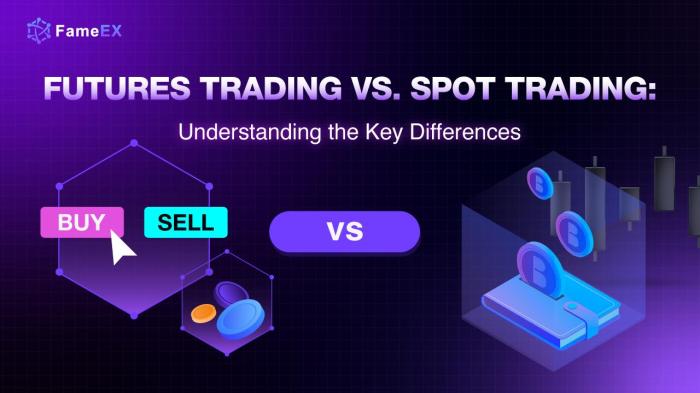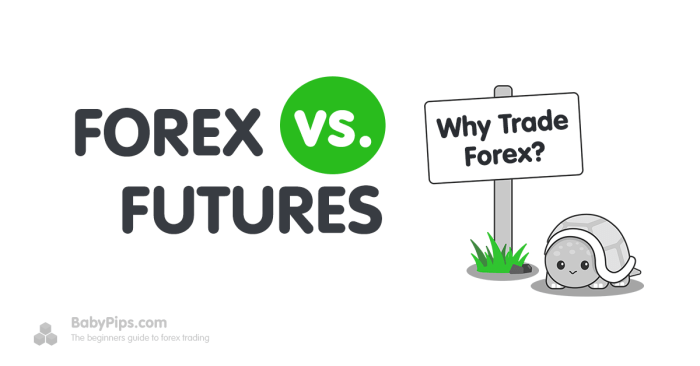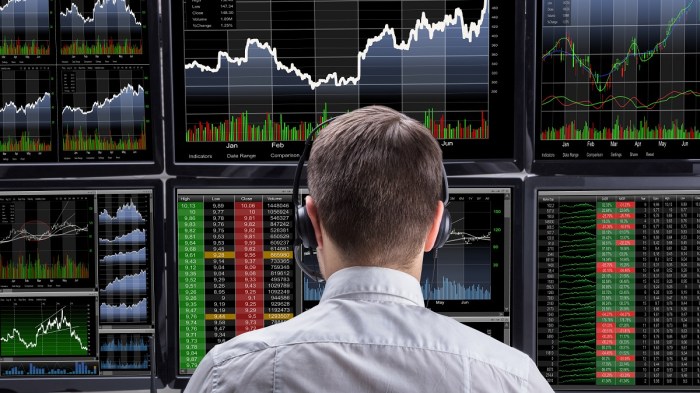
Trading futures vs forex – two titans of the financial world, each with its own unique strengths and weaknesses. Which one reigns supreme? It’s not a simple “this or that” answer; instead, it’s a deep dive into understanding market dynamics, risk tolerance, and your personal trading style. Both offer opportunities for substantial profit, but also carry the potential for significant losses. This exploration will unpack the key differences, helping you navigate this complex landscape and make informed decisions.
We’ll dissect the core distinctions between futures and forex markets, from their underlying assets and trading hours to the intricacies of risk management and regulatory compliance. We’ll compare and contrast popular trading strategies, analyze the role of technical and fundamental analysis, and even delve into the thrilling (and sometimes terrifying) world of leverage. By the end, you’ll have a clearer picture of which market aligns best with your goals and risk appetite.
Market Differences

Futures and forex trading, while both offering opportunities for profit, operate in distinctly different markets with unique characteristics. Understanding these differences is crucial for traders to choose the market best suited to their risk tolerance, trading style, and investment goals. This section delves into the key distinctions between futures and forex markets.
Underlying Assets, Trading futures vs forex
Futures contracts are agreements to buy or sell a specific underlying asset, such as agricultural products (corn, wheat), precious metals (gold, silver), energy (crude oil, natural gas), or financial instruments (stock indices, interest rates), at a predetermined price on a future date. The forex market, on the other hand, deals directly in the exchange of one currency for another. The underlying assets are currencies themselves, with major pairs like EUR/USD or USD/JPY being the most actively traded. This fundamental difference shapes the risk profiles and trading strategies employed in each market. Futures contracts offer exposure to the price movements of a specific commodity or financial instrument, while forex trading focuses on the relative value of different currencies.
Trading Hours and Liquidity
The forex market operates 24 hours a day, five days a week, due to the global nature of currency trading. Liquidity is generally high, especially in major currency pairs, allowing for easy entry and exit from positions. Futures markets, however, have specific trading hours determined by the exchange where the contracts are listed. While liquidity is also generally high in actively traded futures contracts, it can be lower outside of core trading hours and may vary depending on the specific contract and market conditions. The continuous nature of the forex market contrasts with the scheduled trading sessions of futures markets, impacting trading strategies and risk management approaches.
Price Discovery Mechanisms
Both futures and forex markets utilize a decentralized, order-driven price discovery mechanism. However, the specifics differ. In futures markets, prices are determined through the interaction of buyers and sellers on a centralized exchange. Order books, reflecting bid and ask prices, are publicly visible, offering transparency. Forex trading, while also order-driven, is primarily conducted through a network of banks, brokers, and other financial institutions, creating a more decentralized and less transparent environment. While price transparency is generally high in major currency pairs, the lack of a central exchange can lead to variations in pricing across different brokers.
Contract Sizes and Leverage
A significant difference lies in contract sizes and leverage. Futures contracts have standardized contract sizes, meaning a trader buys or sells a specific quantity of the underlying asset with each contract. Forex trading, conversely, allows for greater flexibility in position sizing, with traders able to adjust their lot sizes according to their capital and risk tolerance. Leverage is also significantly different. Futures contracts often offer high leverage, potentially amplifying both profits and losses substantially. Forex trading also uses leverage, but the level of leverage available can vary depending on the broker and regulatory environment. This difference in leverage significantly impacts the risk-reward profile of each market.
| Feature | Futures | Forex |
|---|---|---|
| Typical Contract Size | Standardized (e.g., 500 bushels of corn, 100 ounces of gold) | Variable (e.g., micro lots, mini lots, standard lots) |
| Leverage | High (often 10:1 or greater) | Variable (depends on broker and regulations) |
Risk Management Strategies
Navigating the volatile worlds of futures and forex trading requires a robust risk management plan. While both markets offer lucrative opportunities, the potential for significant losses necessitates a disciplined approach to protect capital and ensure long-term success. Understanding the nuances of risk management specific to each market is crucial for effective trading.
Risk Management Techniques in Futures and Forex
Futures and forex trading, despite sharing some similarities, demand distinct risk management approaches. In futures, the highly leveraged nature of contracts means even small price movements can lead to substantial gains or losses. Forex, while also leveraged, often involves smaller position sizes relative to the total account value, potentially mitigating the impact of individual trades. Common risk management techniques across both include diversification, stop-loss orders, and position sizing. However, the specific implementation and strategies vary based on the market characteristics. For example, hedging strategies in futures often involve offsetting positions in related contracts, while forex hedging might utilize currency pairs to mitigate exposure to specific currencies.
Hedging Strategies: Futures and Forex
Hedging is a crucial risk management tool in both markets. In futures, a farmer might hedge against price drops in their upcoming harvest by selling futures contracts at the current price, guaranteeing a minimum price regardless of future market fluctuations. This locks in a price and reduces uncertainty. Similarly, a company expecting to receive foreign currency payments can hedge against exchange rate risk in forex by buying the relevant currency forward, securing a predetermined exchange rate. The difference lies in the underlying asset being hedged – agricultural commodities in futures versus foreign currencies in forex. Both, however, aim to mitigate risk associated with price volatility.
Risk Management Plan: Futures Trader
A hypothetical futures trader, let’s call him Alex, specializing in agricultural commodities, needs a comprehensive plan. Alex might allocate a maximum of 2% of his capital per trade, using stop-loss orders placed at a level that limits potential losses to a predetermined percentage of his position. He diversifies across various commodities to avoid overexposure to any single market. Regular monitoring of market conditions and news affecting his chosen commodities is critical. His risk management plan includes a detailed record-keeping system, tracking each trade’s performance and identifying areas for improvement. This allows for adaptive risk management based on actual trading experience.
Risk Management Plan: Forex Trader
Consider Sarah, a forex trader focusing on major currency pairs. Sarah’s risk management plan might involve limiting her maximum loss per trade to 1% of her account balance. She might employ trailing stop-loss orders, which adjust automatically as the trade moves in her favor, locking in profits while limiting potential losses. Sarah also uses technical analysis to identify potential entry and exit points, and she diversifies across different currency pairs to reduce risk. Her plan also includes regular reviews of her trading performance, adjusting her strategy based on consistent wins or losses. Furthermore, she’s mindful of geopolitical events that could impact the forex market.
Position Sizing and Stop-Loss Orders
Effective position sizing is paramount in both futures and forex. It involves determining the appropriate amount of capital to allocate to each trade, balancing potential profit with acceptable risk. The common practice is to limit risk per trade to a small percentage of the total account balance (e.g., 1-2%). Stop-loss orders, which automatically close a position when the price reaches a predetermined level, are crucial for limiting potential losses. In futures, stop-loss orders need to account for potential gaps in price, while in forex, the relatively continuous nature of the market makes gap risks less significant. The placement of stop-loss orders is a crucial aspect of risk management in both markets, requiring careful consideration of price volatility and market conditions.
Trading Strategies and Techniques

Futures and forex trading, while both involving speculating on price movements, offer distinct opportunities and challenges. Understanding the nuances of technical and fundamental analysis, as well as employing appropriate trading strategies, is crucial for success in either market. This section delves into the specific strategies and techniques employed in both futures and forex trading, highlighting key differences and similarities.
Technical Analysis Indicators in Futures and Forex
Technical analysis relies on charting patterns and indicators to predict future price movements. While many indicators are used across both markets, their application and interpretation can vary. For instance, moving averages, a cornerstone of technical analysis, are used to identify trends and potential support/resistance levels in both futures and forex. However, the timeframes used might differ; fast-moving averages might be more common in forex due to its higher liquidity and volatility, while longer-term averages might be favored in futures markets, reflecting the often longer-term nature of some futures contracts. Relative Strength Index (RSI) and MACD (Moving Average Convergence Divergence) are also widely used in both markets to identify overbought and oversold conditions, but the optimal settings and interpretation might require adjustments based on the specific market’s volatility and characteristics. For example, a RSI value above 70 might be considered overbought in a less volatile futures market, while a higher value might be needed in a more volatile forex pair.
Fundamental Analysis in Futures and Forex
Fundamental analysis focuses on macroeconomic factors and company-specific data to assess the intrinsic value of an asset. In futures, fundamental analysis often involves examining supply and demand factors affecting the underlying commodity or financial instrument. For example, analyzing weather patterns for agricultural futures, or economic growth indicators for stock index futures. In forex, fundamental analysis involves considering factors like interest rate differentials, inflation rates, political stability, and central bank policies of the countries whose currencies are being traded. Data sources differ significantly: futures traders rely on reports from government agencies, industry organizations, and meteorological services, while forex traders often consult economic calendars, central bank statements, and news releases from financial institutions. The interpretation of this data also varies, with futures analysis focusing more on supply-demand dynamics impacting the physical commodity, while forex analysis emphasizes the impact of macroeconomic factors on currency valuations.
Trading Strategies for Futures and Forex
Choosing the right trading strategy is vital. Here are three examples for each market, recognizing that countless variations exist.
Futures Trading Strategies:
Expand your understanding about spot trading forex with the sources we offer.
- Spread Trading: This involves simultaneously buying and selling two related futures contracts to profit from the price difference between them. For instance, trading the spread between corn and soybean futures, anticipating a price shift in their relative values.
- Scalping: A short-term strategy focusing on quick, small profits from minor price fluctuations. Requires high frequency trading capabilities and tight risk management.
- Swing Trading: Holding positions for several days or weeks, aiming to capitalize on medium-term price swings. This strategy often uses technical indicators to identify entry and exit points.
Forex Trading Strategies:
Understand how the union of forex trading and taxes can improve efficiency and productivity.
- Carry Trade: Borrowing in a low-interest-rate currency to invest in a high-interest-rate currency, profiting from the interest rate differential. However, this strategy carries significant currency risk.
- Trend Following: Identifying and riding established trends in currency pairs. This strategy often uses moving averages and other trend-following indicators.
- News Trading: Capitalizing on market reactions to economic news releases or geopolitical events. Requires quick decision-making and a deep understanding of market sentiment.
Algorithmic Trading in Futures and Forex
Algorithmic trading (often called automated trading or algo-trading) uses computer programs to execute trades based on pre-defined rules and algorithms. Both futures and forex markets are highly conducive to algorithmic trading due to their high liquidity and electronic trading platforms. However, the algorithms themselves might differ based on the market’s characteristics. Forex algorithms often incorporate more sophisticated models incorporating fundamental data and sentiment analysis, given the complex interplay of macroeconomic factors influencing currency prices. Futures algorithms, on the other hand, might focus more on technical indicators and arbitrage opportunities between related contracts. The key difference lies in the data sources and the complexity of the models used. Successful algorithmic trading in either market requires rigorous backtesting, robust risk management, and continuous monitoring and adaptation to changing market conditions. For instance, an algorithm designed to profit from mean reversion in a specific futures contract might need adjustments if market conditions shift towards a sustained trend.
Regulatory Environment and Compliance

Navigating the world of futures and forex trading requires a firm understanding of the regulatory landscape. Both markets are heavily regulated, but the specifics differ significantly, impacting trader obligations and the level of consumer protection afforded. This section will illuminate the key regulatory differences between futures and forex trading, primarily focusing on the United States and the European Union.
Regulatory Frameworks in the US and EU
The regulatory frameworks governing futures and forex trading differ substantially between the US and the EU, reflecting different approaches to market oversight and consumer protection. In the US, futures trading is primarily overseen by the Commodity Futures Trading Commission (CFTC), while forex trading falls under the jurisdiction of multiple agencies, including the Commodity Futures Trading Commission (CFTC) for certain aspects, and the Securities and Exchange Commission (SEC) for others, depending on the nature of the forex product or service. This fragmented approach contrasts with the EU, where the European Securities and Markets Authority (ESMA) plays a more centralized role in regulating both futures and forex markets, aiming for a more harmonized approach across member states. This difference in regulatory structure significantly impacts the level of oversight and the specific rules traders must adhere to. For instance, reporting requirements and capital adequacy rules might vary significantly based on the jurisdiction and the specific market (futures or forex).
Licenses and Registrations for Futures and Forex Trading
Engaging in futures and forex trading activities often requires specific licenses and registrations, depending on the nature of the activity. In the US, futures commission merchants (FCMs) and introducing brokers (IBs) require registration with the CFTC. Similarly, forex brokers often need to register with state or federal authorities, depending on their business model and the services they offer. In the EU, the regulatory landscape for forex and futures brokers is governed by MiFID II (Markets in Financial Instruments Directive II), which sets out licensing requirements for investment firms providing these services. These licenses and registrations are crucial for ensuring compliance and protecting clients. The specific requirements vary based on the jurisdiction and the type of trading activity undertaken. For example, a firm offering leveraged forex trading to retail clients faces stricter regulatory scrutiny than a firm solely dealing in institutional futures contracts.
Reporting Requirements and Compliance Obligations
Both futures and forex traders face various reporting requirements and compliance obligations. Futures traders typically need to report their positions regularly to the relevant exchange and regulatory authorities. These reports help monitor market activity and prevent manipulation. Forex traders also face reporting requirements, although the specifics vary depending on the jurisdiction and the type of trading activity. For instance, larger forex institutions face more stringent reporting requirements than individual retail traders. Moreover, both markets have regulations surrounding record-keeping, anti-money laundering (AML), and know-your-customer (KYC) procedures. Non-compliance can lead to significant penalties, including fines and even criminal charges.
Consumer Protection Mechanisms
Consumer protection mechanisms vary significantly between futures and forex markets. In the US, the CFTC provides a degree of protection for futures traders, including mechanisms for dispute resolution and enforcement actions against fraudulent activities. However, the regulatory framework for forex trading is more fragmented, leading to potentially less robust consumer protection. The EU, through ESMA and national regulatory authorities, generally provides a higher level of consumer protection in both futures and forex markets, with stricter rules on leverage, margin requirements, and investor compensation schemes. These differences highlight the importance of understanding the specific regulatory framework in place before engaging in any trading activity, to ensure adequate protection against potential losses or fraudulent practices.
Illustrative Examples: Trading Futures Vs Forex
Let’s dive into some real-world scenarios to illustrate the nuances of futures and forex trading, showcasing both successful and unsuccessful trades, and the impact of leverage. Understanding these examples will help solidify your comprehension of the market dynamics and risk management involved.
Successful Futures and Forex Trades: A Comparative Look
Successful Futures Trade
Imagine a trader anticipating a surge in corn prices due to a predicted drought. They analyze weather patterns, agricultural reports, and market sentiment, concluding that the price of corn futures contracts will rise. They purchase 10 corn futures contracts at $5.50 per bushel. A week later, their prediction proves accurate, and the price jumps to $6.00 per bushel. Each contract covers 5,000 bushels, resulting in a profit of ($6.00 – $5.50) * 5,000 bushels/contract * 10 contracts = $25,000. This successful trade hinges on accurate market analysis and a well-timed entry point. The trader’s decision-making process involved a thorough fundamental analysis combined with a keen understanding of the market’s reaction to potential supply shortages.
Successful Forex Trade
A trader observes that the Euro is undervalued against the US dollar based on economic indicators suggesting strong Eurozone growth. They believe the Euro will appreciate. They buy 100,000 Euros at an exchange rate of 1.10 USD/EUR. A month later, the Euro strengthens, and the exchange rate rises to 1.15 USD/EUR. Their profit is calculated as (1.15 – 1.10) * 100,000 EUR = $5,000. This successful trade demonstrates the importance of fundamental analysis in currency markets, accurately predicting the direction of currency pairs based on macroeconomic factors. The trader’s decision-making involved a careful evaluation of economic data and an understanding of the market’s reaction to positive economic news.
Losing Futures and Forex Trades: Lessons Learned
Losing Futures Trade
Consider a trader who takes a short position on oil futures, betting on a price drop. However, an unexpected geopolitical event causes a significant surge in oil prices. Their short position results in substantial losses because the price moves against their prediction. Contributing factors could include a lack of contingency planning for unforeseen events and neglecting to incorporate geopolitical risk factors into their analysis. Mitigation strategies could have included setting stop-loss orders to limit potential losses and diversifying their portfolio to reduce the impact of a single trade.
Losing Forex Trade
A trader enters a long position on the British Pound against the Japanese Yen, expecting a strengthening of the Pound. However, unexpected negative economic news regarding the UK causes a sharp decline in the Pound’s value. This results in a significant loss for the trader. Contributing factors might include relying solely on technical analysis without considering fundamental economic data and a lack of risk management strategies like stop-loss orders. Mitigation strategies could have included a more thorough fundamental analysis and the implementation of effective risk management techniques.
Leverage: Amplifying Gains and Losses
Leverage Amplification
Leverage magnifies both profits and losses exponentially. Let’s illustrate this with examples in both futures and forex:
- Futures: A trader uses 10:1 leverage to buy 10 contracts of a commodity at $100 per contract. Their initial investment is $1,000. If the price rises to $110, their profit is $10 per contract * 10 contracts = $100. However, due to leverage, this translates to a 10% return on their initial investment ($100/$1000). Conversely, if the price falls to $90, their loss is also amplified to a 10% loss on their initial investment.
- Forex: A trader uses 50:1 leverage to buy $50,000 worth of EUR/USD at an exchange rate of 1.10. Their initial margin is only $1,000. If the exchange rate rises to 1.15, their profit is amplified by the leverage. However, if the exchange rate falls, their losses are also amplified, potentially exceeding their initial margin, leading to a margin call.
Last Point
So, futures or forex? The ultimate victor depends entirely on your individual circumstances. Futures offer the precision of standardized contracts and the potential for leveraged gains, but demand a sharp understanding of market dynamics and risk management. Forex, with its immense liquidity and 24/5 accessibility, provides a different set of challenges and opportunities. By carefully weighing the pros and cons of each, understanding your risk profile, and developing a robust trading strategy, you can navigate these markets successfully and potentially reap substantial rewards. Remember, though, consistent learning and adaptation are key to long-term success in any financial market.




